化工专业英语翻译(华东理工 最完整版本 包括第八第九单元)
化工专业英语第一到第八单元单词
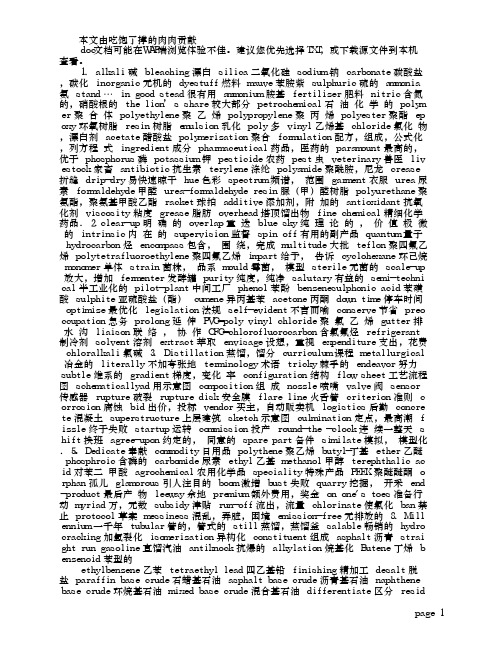
本文由吃饱了撑的肉肉贡献 doc文档可能在WAP端浏览体验不佳。
建议您优先选择TXT,或下载源文件到本机查看。
1.alkali 碱 bleaching 漂白 silica 二氧化硅 sodium 钠 carbonate 碳酸盐,碳化 inorganic 无机的 dyestuff 燃料 mauve 苯胺紫 sulphuric 硫的 ammonia 氨 stand … in good stead 很有用 ammonium 胺基 fertilizer 肥料 nitric 含氮的,硝酸根的 the lion’s share 较大部分 petrochemical 石 油 化 学 的 polymer 聚 合 体 polyethylene 聚 乙 烯 polypropylene 聚 丙 烯 polyester 聚酯 epoxy 环氧树脂 resin 树脂 emulsion 乳化 poly 多 vinyl 乙烯基 chloride 氯化 物,漂白剂 acetate 醋酸盐 polymerization 聚合 formulation 配方,组成,公式化,列方程 式 ingredient 成分 pharmaceutical 药品,医药的 paramount 最高的,优于 phosphorus 磷 potassium 钾 pesticide 农药 pest 虫 veterinary 兽医 livestock 家畜 antibiotic 抗生素 terylene 涤纶 polyamide 聚酰胺,尼龙 crease 折缝 drip-dry 易快速晾干 hue 色彩 spectrum 频谱, 范围 garment 衣服 urea 尿素 formaldehyde 甲醛 urea-formaldehyde resin 脲(甲)醛树脂 polyurethane 聚氨酯,聚氨基甲酸乙酯 racket 球拍 additive 添加剂,附 加的 antioxidant 抗氧化剂 viscosity 粘度 grease 脂肪 overhead 塔顶馏出物 fine chemical 精细化学药品. 2.clear-up 明 确 的 overlap 重 迭 blue sky 纯 理 论 的 , 价 值 极 微 的 intrinsic 内 在 的 supervision 监督 spin off 有用的副产品 quantum 量子 hydrocarbon 烃 encompass 包含, 围 绕,完成 multitude 大批 teflon 聚四氟乙烯 polytetrafluoroethylene 聚四氟乙烯 impart 给予, 告诉 cyclohexane 环己烷 monomer 单体 strain 菌株, 品系 mould 霉菌, 模型 sterile 无菌的 scale-up 放大,增加 fermenter 发酵罐 purity 纯度,纯净 salutary 有益的 semi-technical 半工业化的 pilot-plant 中间工厂 phenol 苯酚 benzenesulphonic acid 苯磺酸 sulphite 亚硫酸盐(酯) cumene 异丙基苯 acetone 丙酮 down time 停车时间 optimize 最优化 legislation 法规 self-evident 不言而喻 conserve 节省 preoccupation 急务 prolong 延 伸 PVC=poly vinyl chloride 聚 氯 乙 烯 gutter 排 水 沟 liaison 联 络 , 协 作 CFC=chlorofluorocarbon 含氯氟烃 refrigerant 制冷剂 solvent 溶剂 extract 萃取 envisage 设想,重视 expenditure 支出,花费 chloralkali 氯碱 3.Distillation 蒸馏,馏分 curriculum 课程 metallurgical 冶金的 literally 不加夸张地 terminology 术语 tricky 棘手的 endeavor 努力 subtle 维系的 gradient 梯度,变化 率 configuration 结构 flow sheet 工艺流程图 schematicallyad 用示意图 composition 组 成 nozzle 喷嘴 valve 阀 sensor 传感器 rupture 破裂 rupture disk 安全膜 flare line 火舌管 criterion 准则 corrosion 腐蚀 bid 出价,投标 vendor 买主,自动贩卖机 logistics 后勤 concrete 混凝土 superstructure 上层建筑 sketch 示意图 culmination 定点,最高潮 fizzle 终于失败 startup 运转 commission 投产 round-the -clock 连 续一整天 shift 换班 agree-upon 约定的, 同意的 spare part 备件 similate 模拟, 模型化. 5。
化工专业英语课文翻译
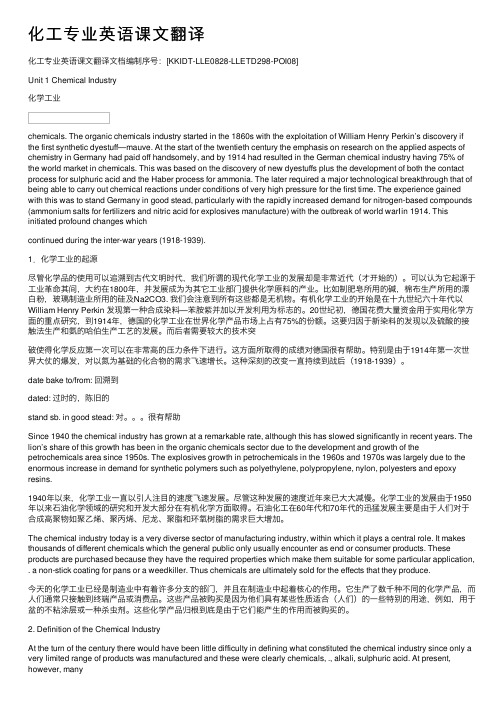
化⼯专业英语课⽂翻译化⼯专业英语课⽂翻译⽂档编制序号:[KKIDT-LLE0828-LLETD298-POI08]Unit 1 Chemical Industry化学⼯业chemicals. The organic chemicals industry started in the 1860s with the exploitation of William Henry Perkin’s discovery if the first synthetic dyestuff—mauve. At the start of the twentieth century the emphasis on research on the applied aspects of chemistry in Germany had paid off handsomely, and by 1914 had resulted in the German chemical industry having 75% of the world market in chemicals. This was based on the discovery of new dyestuffs plus the development of both the contact process for sulphuric acid and the Haber process for ammonia. The later required a major technological breakthrough that of being able to carry out chemical reactions under conditions of very high pressure for the first time. The experience gained with this was to stand Germany in good stead, particularly with the rapidly increased demand for nitrogen-based compounds (ammonium salts for fertilizers and nitric acid for explosives manufacture) with the outbreak of world warⅠin 1914. This initiated profound changes whichcontinued during the inter-war years (1918-1939).1.化学⼯业的起源尽管化学品的使⽤可以追溯到古代⽂明时代,我们所谓的现代化学⼯业的发展却是⾮常近代(才开始的)。
化学化工专业英语课文翻译第八课8.2
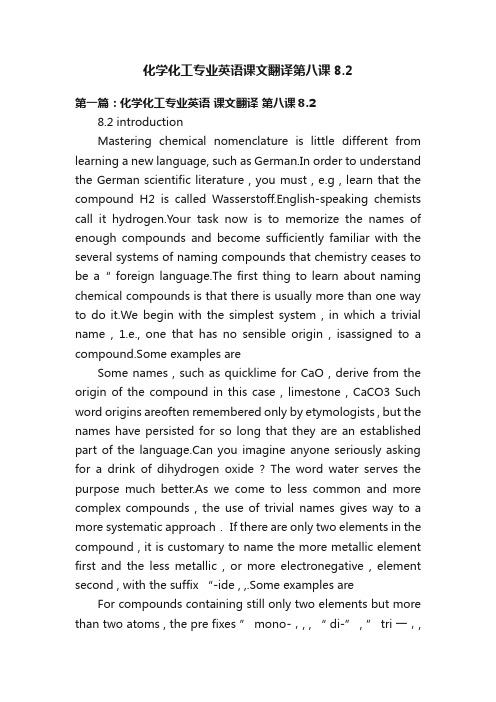
化学化工专业英语课文翻译第八课8.2第一篇:化学化工专业英语课文翻译第八课8.28.2 introductionMastering chemical nomenclature is little different from learning a new language, such as German.In order to understand the German scientific literature , you must , e.g , learn that the compound H2 is called Wasserstoff.English-speaking chemists call it hydrogen.Your task now is to memorize the names of enough compounds and become sufficiently familiar with the several systems of naming compounds that chemistry ceases to be a“ foreign language.The first thing to learn about naming chemical compounds is that there is usually more than one way to do it.We begin with the simplest system , in which a trivial name , 1.e., one that has no sensible origin , isassigned to a compound.Some examples areSome names , such as quicklime for CaO , derive from the origin of the compound in this case , limestone , CaCO3 Such word origins areoften remembered only by etymologists , but the names have persisted for so long that they are an established part of the language.Can you imagine anyone seriously asking for a drink of dihydrogen oxide ? The word water serves the purpose much better.As we come to less common and more complex compounds , the use of trivial names gives way to a more systematic approach. If there are only two elements in the compound , it is customary to name the more metallic element first and the less metallic , or more electronegative , element second , with the suffix “-ide , ,.Some examples areFor compounds containing still only two elements but more than two atoms , the pre fixes ” mono-,, , “ di-” , ” tri 一,,etc , become necessary.Some examples of such compounds are the oxides of nitrogen.Another such series is that of the oxide of chlorine.Because chlorine , like nitrogen , is slightly less electronegative than oxygen , the word chlorine cornes first if no confusion can result , the prefixes “ mono , , and “di-, are sometimes dropped.Aclassofcompounds in which such prefixes are seldom used is that in which the metal atom usually exhibits only one oxidation state Depending on the oxidation state of the other element , the number of anionsper cation is then fixed.Some examples areThe next level of complexity in naming Inorganic compounds arises when there are three elements present.Very often , one of these elements is oxygen.Such compounds are named by combining the suffix “ ate “ , with the name of the less electronegative of the two nonmetallic elements.For example , NaNo3 is sodium nitrate.The problem with this is that there is a similar compound withnitrogen in the + 3 oxidation state , NaNO2.suchcompounds with the element in a lower oxidation state use the suffix “-ite , , , so NaNO2 is sodium nitrite.But the number of chemical compounds is not bounded by thechemists ' vocabulary ,and there are several such examples entailing more than two oxidation states.To solve this problem , the prefix ' ' hy-po 一,,(meaning ” below , ,)is used in the name of the compound In which the less electronegative element is in the lowest oxidation state , and theprefix “ per-,,(meaning ” highest , ,)is usedwhen it is in the highest oxidation state Some examples of the use of this system are shown In the following table(Table 8.2) In the inor ganic acids , the suffixes “-ous , , and “-ic , , are used to denote the lower and higher oxidation states ,respectively These same suffixes are also used with the names of a number of metals , namely , those that usually exhibit more than one oxidation state Some examples are cobaltous and cobaltic , and mercurous and mercuric.The nomenclature is complicated slightly by the fact that , for a few such metals , these terms are derived from the Latin name of the element rather than the English name.All but eleven of the elements are given a symbol corresponding to one or two letters In the English name of the compound(The first letter is always capitalized and the second letter 15 never capitalized)One of these exceptions istungsten , whose symbol(W)is derived from the German name of the element , Wolfram The other ten have symbols derived from their Latin names.These are , stibium(Sb)for antimony , cuprum(Cu)forcopper , aurum(Au)for gold,ferrum(Fe)for iron , plumbum(Pb)for lead , hydrargyrum(Hg)for mercury , kalium(K)for potassium , argentum(Ag)for silver , natrium(Na)for sodium , and stannum(Sn)for tin.The use of the suffixes ' ’-ous , , and “-ic , , with three of these metals 15 illustrated below The system works well as long as there are only two major oxidation states of the metal atom , as in those examples.The most rational and selfconsistent system of nomenclature of inorganic compounds is that adopted in 1957 by the ultimate authority in such matters , the International Union of Pure and Applied Chemistry.theserules , popularly called the IUPAC Rules , are the model for chemists throughout the world to follow , and are becoming ever more dominant In the chemical literature.Note that the oxidation state of the metal atom is specified by a Roman numeral whenever there could be some doubt about it , but not otherwise Let us see how the examples shown above are named according to this system掌握化学命名是学习新的语言,如德国略有不同。
最新《化学工程与工艺专业英语》课文翻译-完整版
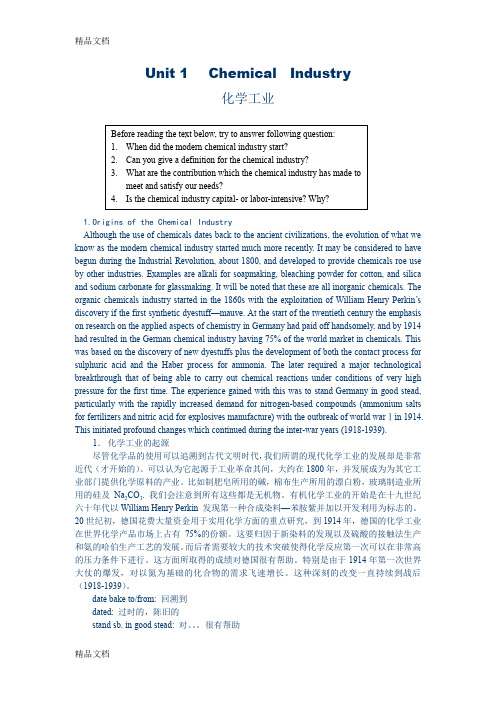
Unit 1 Chemical Industry化学工业1.Origins of the Chemical IndustryAlthough the use of chemicals dates back to the ancient civilizations, the evolution of what we know as the modern chemical industry started much more recently. It may be considered to have begun during the Industrial Revolution, about 1800, and developed to provide chemicals roe use by other industries. Examples are alkali for soapmaking, bleaching powder for cotton, and silica and sodium carbonate for glassmaking. It will be noted that these are all inorganic chemicals. The organic chemicals industry started in the 1860s with the exploitation of William Henry Perkin’s discovery if the first synthetic dyestuff—mauve. At the start of the twentieth century the emphasis on research on the applied aspects of chemistry in Germany had paid off handsomely, and by 1914 had resulted in the German chemical industry having 75% of the world market in chemicals. This was based on the discovery of new dyestuffs plus the development of both the contact process for sulphuric acid and the Haber process for ammonia. The later required a major technological breakthrough that of being able to carry out chemical reactions under conditions of very high pressure for the first time. The experience gained with this was to stand Germany in good stead, particularly with the rapidly increased demand for nitrogen-based compounds (ammonium salts for fertilizers and nitric acid for explosives manufacture) with the outbreak of world warⅠin 1914. This initiated profound changes which continued during the inter-war years (1918-1939).1.化学工业的起源尽管化学品的使用可以追溯到古代文明时代,我们所谓的现代化学工业的发展却是非常近代(才开始的)。
化工专业英语第八单元翻译

化工专业英语第八单元翻译第八单元石油加工Unit 8 Petroleum Processing石油是有机物几千年自然变化生成的,在地下聚集很大的数量,石油被人类发现和使用。
它用来满足人们的需要,石油是成千上万有机物组成的混合物,通过改变精炼和加工的方式生产不同的燃料。
石油化工产品通过化学反应生产纯的化学物质。
Petroleum was produced by thousands of years’ natural change of organic. It gatheredinto a great amount in underground and it was discovered and used by human beings tosatisfy their needs. Petroleum is a mixture of thousands of organic composition. By changing the methods of refining and processing, it was produced into different fuels. Petrochemical products produce pure chemicals by chemical reactions.现代工业是连续的操作过程。
首先,管式加热器加热原油,通过沸点分离这些物质,和间歇蒸馏得到的物质相似。
但是这种分离方法更好。
使用的程序包括分裂,聚合,加氢裂化,加氢处理,异构化,焦化处理。
很多化学过程被设计用来改变沸点和分子结构。
Modern industry is a continuous operation process. First of all, tubular heaters heat the crude petroleum. Then separate these substancesthrough the boiling point, which are similar to the substances via batch distillation. But this separation method is better. The process of usage includes split, polymerization, hydro cracking, hydro treating, isomerization and coking processing. A lot of chemical processes are designed to change the boiling point and molecular structure.石油的组成The composition of petroleum原油是由几千种不同的化学物质组成,包括气体、液体、固体以及甲烷,沥青,大多数成分是烃类,但也含有氮,硫磺,氧化物。
化工专业英语lesson8翻译汇编
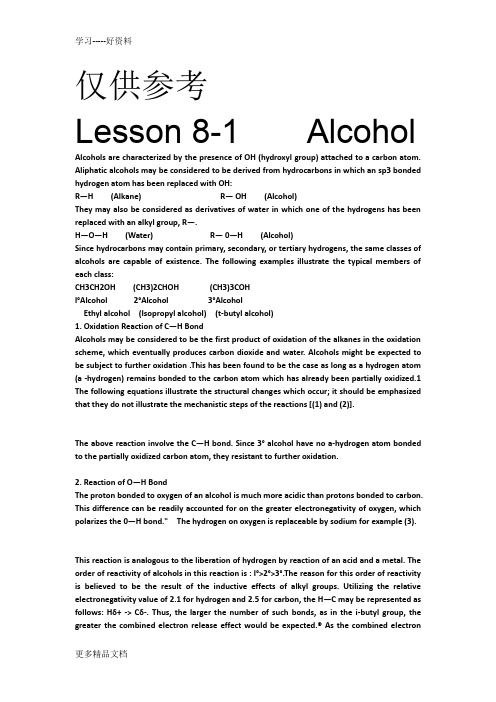
仅供参考Lesson 8-1 Alcohol Alcohols are characterized by the presence of OH (hydroxyl group) attached to a carbon atom. Aliphatic alcohols may be considered to be derived from hydrocarbons in which an sp3 bonded hydrogen atom has been replaced with OH:R—H (Alkane) R— OH (Alcohol)They may also be considered as derivatives of water in which one of the hydrogens has been replaced with an alkyl group, R—.H—O—H (Water) R— 0—H (Alcohol)Since hydrocarbons may contain primary, secondary, or tertiary hydrogens, the same classes of alcohols are capable of existence. The following examples illustrate the typical members of each class:CH3CH2OH (CH3)2CHOH (CH3)3COHl°Alcohol 2°Alcohol 3°AlcoholEthyl alcohol (Isopropyl alcohol) (t-butyl alcohol)1. Oxidation Reaction of C—H BondAlcohols may be considered to be the first product of oxidation of the alkanes in the oxidation scheme, which eventually produces carbon dioxide and water. Alcohols might be expected to be subject to further oxidation .This has been found to be the case as long as a hydrogen atom (a -hydrogen) remains bonded to the carbon atom which has already been partially oxidized.1 The following equations illustrate the structural changes which occur; it should be emphasized that they do not illustrate the mechanistic steps of the reactions [(1) and (2)].The above reaction involve the C—H bond. Since 3° alcohol have no a-hydrogen atom bonded to the partially oxidized carbon atom, they resistant to further oxidation.2. Reaction of O—H BondThe proton bonded to oxygen of an alcohol is much more acidic than protons bonded to carbon. This difference can be readily accounted for on the greater electronegativity of oxygen, which polarizes the 0—H bond." The hydrogen on oxygen is replaceable by sodium for example (3).This reaction is analogous to the liberation of hydrogen by reaction of an acid and a metal. The order of reactivity of alcohols in this reaction is : l°>2°>3°.The reason for this order of reactivity is believed to be the result of the inductive effects of alkyl groups. Utilizing the relative electronegativity value of 2.1 for hydrogen and 2.5 for carbon, the H—C may be represented as follows: Hδ+ -> Cδ-. Thus, the larger the number of such bonds, as in the i-butyl group, the greater the combined electron release effect would be expected.® As the combined electronrelease effect increases, the greater the destabilizing effect on the alkoxide anion, which thus accounts for the observed order of reactivity: 1°>2°>3°.Lesson 8-1 Alcohol醇的特点是碳原子上连接着羟基。
《化学工程与工艺专业英语》课文翻译完整版

Unit 1 Chemic al Indust ry化学工业1.Origin s of the Chemic al Indust ryAlthou gh the use of chemic als datesback to the ancien t civili zatio ns, the evolut ion of what we know as the modern chemic al indust ry starte d much more recent ly. It may be consid eredto have begunduring the Indust rialRevolu tion, about1800, and develo ped to provid e chemic als roe use by otherindust ries. Exampl es are alkali for soapma king, bleach ing powder for cotton, and silica and sodium carbon ate for glassm aking. It will be notedthat theseare all inorga nic chemic als. The organi c chemic als indust ry starte d in the 1860swith the exploi tatio n of Willia m HenryPerkin‘sdiscov ery if the firstsynthe tic dyestu ff—mauve. At the startof the twenti eth centur y the emphas is on resear ch on the applie d aspect s of chemis try in German y had paid off handso mely, and by 1914 had result ed in the German chemic al indust ry having 75% of the worldmarket in chemic als. This was basedon the discov ery of new dyestu ffs plus the develo pment of both the contac t proces s for sulphu ric acid and the Haberproces s for ammoni a. The laterrequir ed a majortechno logic al breakt hroug h that of beingable to carryout chemic al reacti ons undercondit ionsof very high pressu re for the firsttime. The experi encegained with this was to standGerman y in good stead, partic ularl y with the rapidl y increa sed demand for nitrog en-basedcompou nds (ammoni um saltsfor fertil izers and nitric acid for explos ivesmanufa cture) with the outbre ak of worldwarⅠin 1914. This initia ted profou nd change s whichcontin ued during the inter-war years(1918-1939).1.化学工业的起源尽管化学品的使用可以追溯到古代文明时代,我们所谓的现代化学工业的发展却是非常近代(才开始的)。
化工专业英语翻译(华东理工_最完整版本_包括第八第九单元)

Unit 2 Research and Development研究和开发Research and development, or R&D as it is commonly referred to, is an activity which is carried out by all sectors of manufacturing industry but its extent varies considerably, as we will see shortly. Let us first understand, or at least get a feel for, what the terms mean. Although the distinction between research and development is not always clear-cut, and there is often considerable overlap, we will attempt to separate them. In simple terms research can be thought of as the activity which produces new ideas and knowledge whereas development is putting those ideas into practice as new process and products. To illustrate this with an example, predicting the structure of a new molecule which would have a specific biological activity and synthesizing it could be seen as research whereas testing it and developing it to the point where it could be marketed as a new drug could be described as the development part.研究和开发,或通常所称R&D是制造业各个部门都要进行的一项活动。
化工专业英语翻译

化工专业英语翻译IntroductionChemical engineering is a branch of engineering that applies the principles of chemistry, physics, biology, and mathematics to solve problems related to the production, transformation, and use of chemicals and materials. With the globalization of industries, there is an increasing demand for effective communication and understanding in the field of chemical engineering. This has led to the development of specialized English terminology and vocabulary in this discipline. In this document, we will explore various aspects of chemical engineering and provide translations of common terms and phrases in English.Unit OperationsUnit operations are fundamental steps in chemical engineering processes. These operations involve the physical and chemical changes that occur during the production and transformation of raw materials. Here are some English translations of common unit operations:1. Distillation (蒸馏): A process of separating the components of a mixture based on their different boiling points.2. Evaporation (蒸发): The conversion of a liquid into a vapor by adding heat.3. Filtration (过滤): The process of separating solid particles from a liquid or gas by passing it through a porous medium.4. Crystallization (结晶): The formation of solid crystals from a liquid or gas phase.5. Extraction (萃取): The process of selectively removing a specific component from a mixture using a solvent.6. Reactor (反应器): A vessel where chemical reactions take place to convert raw materials into desired products.Chemical ReactionsChemical reactions play a crucial role in chemical engineering processes. These reactions involve the conversion of reactants into products through the breaking and formation of chemical bonds. Here are some translations of common terms related to chemical reactions:1. Reaction rate (反应速率): The speed at which a chemical reaction proceeds.2. Catalyst (催化剂): A substance that increases the rate of a chemical reaction without being consumed in the process.3. Yield (产率): The amount of desired product obtained froma chemical reaction, usually expressed as a percentage of the theoretical maximum.4. Equilibrium (平衡): A state in which the rates of the forward and reverse reactions are equal, resulting in no net change in the concentrations of reactants and products.5. Kinetics (动力学): The study of rates of chemical reactions and the factors that influence them.Safety and Environmental ConcernsChemical engineering also involves the responsibility of ensuring the safety of processes and minimizing environmental impacts. Here are some translations of terms related to safety and environmental concerns:1. Hazard (危险): A potential source of harm or danger.2. Risk assessment (风险评估): The process of identifying and analyzing potential risks associated with a chemical process or operation.3. PPE (Personal Protective Equipment, 个人防护设备): Equipment designed to protect individuals from hazards inthe workplace, such as protective clothing, goggles, and respirators.4. Pollution prevention (污染防治): The practice of reducing or eliminating pollution at its source to minimize its impact on the environment.5. Waste treatment (废物处理): The process of treating and disposing of waste materials generated from chemical processes in a safe and environmentally responsible manner.ConclusionChemical engineering is a complex and multidisciplinary field that requires effective communication and understanding of specialized terminology and concepts. This document has provided translations of common terms and phrases in English related to unit operations, chemical reactions, and safety and environmental concerns in chemical engineering. It is important for professionals in this field to have a good command of both their native language and English in order to effectively communicate with colleagues and counterparts around the world.。
《化学工程与工艺专业英语》课文翻译全
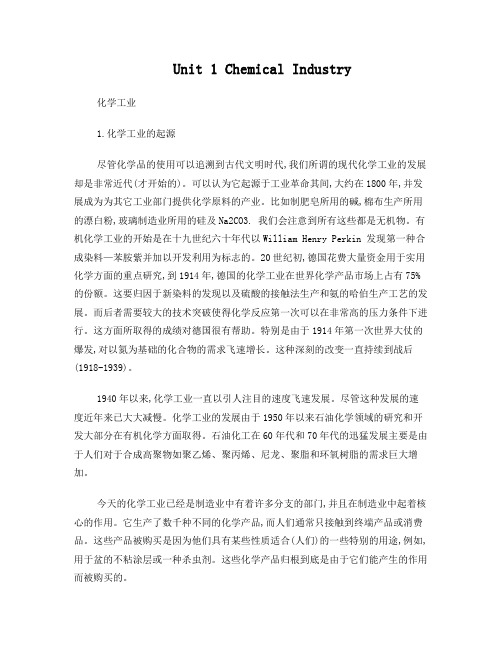
Unit 1 Chemical Industry化学工业1.化学工业的起源尽管化学品的使用可以追溯到古代文明时代,我们所谓的现代化学工业的发展却是非常近代(才开始的)。
可以认为它起源于工业革命其间,大约在1800年,并发展成为为其它工业部门提供化学原料的产业。
比如制肥皂所用的碱,棉布生产所用的漂白粉,玻璃制造业所用的硅及Na2CO3. 我们会注意到所有这些都是无机物。
有机化学工业的开始是在十九世纪六十年代以William Henry Perkin 发现第一种合成染料—苯胺紫并加以开发利用为标志的。
20世纪初,德国花费大量资金用于实用化学方面的重点研究,到1914年,德国的化学工业在世界化学产品市场上占有75%的份额。
这要归因于新染料的发现以及硫酸的接触法生产和氨的哈伯生产工艺的发展。
而后者需要较大的技术突破使得化学反应第一次可以在非常高的压力条件下进行。
这方面所取得的成绩对德国很有帮助。
特别是由于1914年第一次世界大仗的爆发,对以氮为基础的化合物的需求飞速增长。
这种深刻的改变一直持续到战后(1918-1939)。
1940年以来,化学工业一直以引人注目的速度飞速发展。
尽管这种发展的速度近年来已大大减慢。
化学工业的发展由于1950年以来石油化学领域的研究和开发大部分在有机化学方面取得。
石油化工在60年代和70年代的迅猛发展主要是由于人们对于合成高聚物如聚乙烯、聚丙烯、尼龙、聚脂和环氧树脂的需求巨大增加。
今天的化学工业已经是制造业中有着许多分支的部门,并且在制造业中起着核心的作用。
它生产了数千种不同的化学产品,而人们通常只接触到终端产品或消费品。
这些产品被购买是因为他们具有某些性质适合(人们)的一些特别的用途,例如,用于盆的不粘涂层或一种杀虫剂。
这些化学产品归根到底是由于它们能产生的作用而被购买的。
2.化学工业的定义在本世纪初,要定义什么是化学工业是不太困难的,因为那时所生产的化学品是很有限的,而且是非常清楚的化学品,例如,烧碱,硫酸。
《化学工程与工艺专业英语》中英文翻译
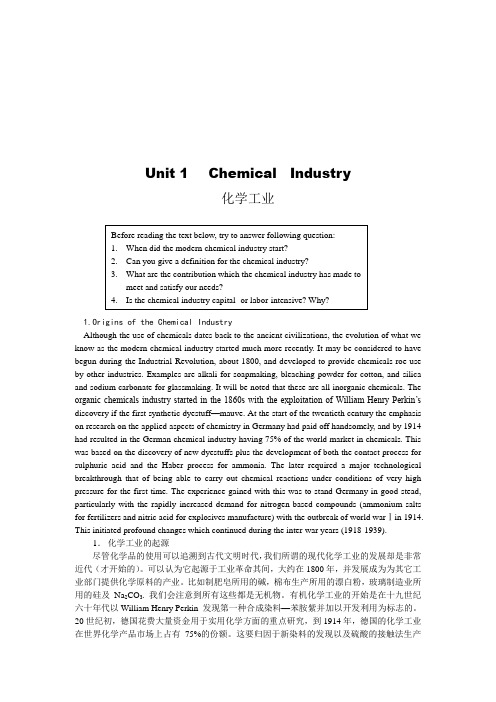
Unit 1 Chemical Industry化学工业1.Origins of the Chemical IndustryAlthough the use of chemicals dates back to the ancient civilizations, the evolution of what we know as the modern chemical industry started much more recently. It may be considered to have begun during the Industrial Revolution, about 1800, and developed to provide chemicals roe use by other industries. Examples are alkali for soapmaking, bleaching powder for cotton, and silica and sodium carbonate for glassmaking. It will be noted that these are all inorganic chemicals. The organic chemicals industry started in the 1860s with the exploitation of William Henry Perkin’s discovery if the first synthetic dyestuff—mauve. At the start of the twentieth century the emphasis on research on the applied aspects of chemistry in Germany had paid off handsomely, and by 1914 had resulted in the German chemical industry having 75% of the world market in chemicals. This was based on the discovery of new dyestuffs plus the development of both the contact process for sulphuric acid and the Haber process for ammonia. The later required a major technological breakthrough that of being able to carry out chemical reactions under conditions of very high pressure for the first time. The experience gained with this was to stand Germany in good stead, particularly with the rapidly increased demand for nitrogen-based compounds (ammonium salts for fertilizers and nitric acid for explosives manufacture) with the outbreak of world warⅠin 1914. This initiated profound changes which continued during the inter-war years (1918-1939).1.化学工业的起源尽管化学品的使用可以追溯到古代文明时代,我们所谓的现代化学工业的发展却是非常近代(才开始的)。
化工专业英语

化学专业课程中英文对照普通化学 General Chemistry 分析化学 Analytical Chemistry 有机化学 Organic Chemistry 物理化学 Physical Chemistry 谱学导论 Introducton of Spectroscopy 无机化学 Inorganic Chemistry 普通化学和分析化学实验 Experiments of General and Analytical Chemistry 现在基础化学 The Principle of Mordern Chemistry 现在基础化学实验 Experiments of Modern Fundamental Chemistry 有机化学实验 Experiments of Organic Chemistry 仪器分析和物理化学实验 Experiments of Instrumental Analysis and Physical Chemistry 合成化学实验 Experiments of Synthetic Chemistry 现代化学专题Topic of Modern Chemistry 化学综合实验 Experiments of Comprehensive Chemistry 化工原理 Principle of Chemical Engineering 化工原理实验 Experiments of Chemical Engineering 应用化学实验 Experiments of Applied Chemistry 无机合成化学 Synthetic Inorganic Chemistry 近代分析化学 Modern Analytical Chemistry 分离分析化学Separation Analytical Chemistry 有机化合物波谱鉴定 Spectrum Identification of Organic Compounds 有机合成及反应机理 Organic Synthesis and Mechanics 化学进展Progress in Chemistry 化学反应工程 Chemical Reaction Engineering 应用电化学Applied Electrochemistry 工业催化 Industrial Catalysis 环境化学 Environmental Chemistry 环境监测 Environmental Monitoring 化学科技英语 Scientific English for Chemistry 数理方法在化学中的应用 Mathematical Statistics for Chemistry 化工制图Chemical Engineering Cartography 计算机与化学测量实验 Computer and Chemical Measurement 化学信息学 Chemoinformatics or Chemical Informatics 应用化学专题Special Topics in Applied Chemistry化工装置常用词汇 1一概论 introduction 方案(建议书) proposal 可行性研究 feasibility study 方案设计concept design 工艺设计 process design 基础设计 basic design 详细设计 detail design 开工会议 kick-off meeting 审核会议 review meeting 外商投资 foreign investment 中外合资 joint venture 中外合营 joint venture 补偿贸易 compensation trade 合同合同附件 contract 卖方 vendor 买方 buyer 顾客 client 承包商contractor 工程公司 company 供应范围 scope of supply 生产范围 production scope生产能力 production capacity 项目 project 界区 battery limit 装置 plant 公用工程utilities 工艺流程图 process flow diagram 工艺流程方块图 process block diagram 管道及仪表流程图 piping and instrument drawing 物料及热量平衡图 mass & heat balance diagram 蒸汽及冷凝水平衡图 steam & condensate balance diagram 设备布置图equipment layout 设备表 equipment list 成品(产品) product(final product) 副产品by-product 原料 raw-material 设计基础数据 basic data for design 技术数据technical data 数据表 data sheet 设计文件 design document 设计规定 design regulation 现场服务 site service 项目变更 project change 用户变更 client change 消耗定额 consumption quota 技术转让 technical transfer 技术知识 technicalknow-how technical knowledge 技术保证 technical guarantee 咨询服务 consultative services 技术服务 technical services 工作地点 location 施工现场 construction field 报价 quotation 标书 bidding book 公司利润 company profit 固定价合同 fixed price contract 固定单价合同 fixed unit price contract 成本加酬金合同 cost plus award fee contract 定金 mobilization 银行保证书 bank guarantee letter 保留金retention 所得税 income taxes 特别承包人税 special contractor's taxes 城市和市政税 city and municipal taxes 工作手册 work manual 工作流程图 work flow diagram 质量保证程序 QA/QC procedures 采购计划 procurement plan 施工计划 construction plan 施工进度 construction schedule 项目实施计划 project execution plan 项目协调程序project coordination procedure 项目总进度计划 project master schedule 设计网络计划 engineering network logic 项目质量保证 project quality assurance 项目质量控制project quality control 采购 procurement 采购周期 procurement period 会签 the squad check 计算书 calculation sheets 询价 inquiry 检验 inspection 运输transportation 开车 start up / commission 验收 inspection & acceptance 校核 check 审核 review 审定 approve 版次 version 部门 department 专业 specialty 项目号project number 图号 drawing number 目录 contents 序言 foreword 章 chapter 节section 项 item MR material requisition SPEC engineering specification DATA SHEET (技术表) technical data sheet TBA(技术评标) technical bid analysis PDP preliminary design package PM (项目经理) project manager LDE(专业负责人) lead discipline engineer Material requisition for quotation MRQ(材料询价单) MRP(材料采购单) material requisition for purchase BEP(基础工程设计包) basic engineering package P&ID(管道及仪表流程图) piping and instrument drawing(diagram) PFD process flow diagram NNF normally no flow FO failure open FC failure close C/S/Acivil/structure/architecture detail design phase DDP(详细设计阶段)二. 工艺流程连续过程 continuous process 间歇过程 batch process 工艺叙述 process description 工艺特点 process feature 操作 operation 反应 reaction 副反应 side reaction 絮凝flocculation 浮洗 flotation 倾析 decantation 催化反应 catalytical reaction 萃取extraction 中和 neutralization 水解 hydrolysis 过滤 filtration 干燥 drying 还原reduction 氧化 oxidation 氢化 hydrogenation 分解 decomposition 离解dissociation 合成 synthetics 吸收 absorption 吸附 adsorption 解吸 desorption 结晶 crystallization 溶解 solution 调节 modulate 控制 control 悬浮 suspension 循环 circulation 再生 regeneration 再活化 reactivation 沥取 leaching 破碎crushing 煅烧 caloination 沉降 sedimentation 沉淀 precipitation 气化gasification 冷冻 refrigeration 固化、结晶 solidification 包装 package 升华sublimation 燃烧 combustion 引烧 ignition 蒸馏 distillation 碳化 carbonization 压缩 compression三、化学物质及特性固体 solid 液体 liquid 气体 gas 化合物 compound 混合物 mixture 粉 powder 片状粉未 flake 小粒 granule 结晶 crystal 乳化物 emulsion 氧化物 oxidizing agent 还原剂 reducing agent 有机物 organic material 真空 vacuum 母液 master liquor 富液rich liquor 贫液 lean liquor 萃出物 extract 萃余物 raffinate 絮凝剂 flocculants 冷冻盐水 brine 酸度 acidity 浓度 concentration 碱度 alkalinity 溶解度solubility 凝固点 solidificalion point 沸点 boiling point 熔点 melting point 蒸发率 evaporation rate 粘度 viscosity 吸水的 water absorbent(a) 无水的anhydrous(a) 外观 appearance 无色的 colorless(a) 透明的 transparent(a) 半透明的translucent 密度 density 比重 specific gravity 催化剂 catalyst 燃烧 combustion 引燃 ignition 自然点 self-ignition temperature 可燃气体 combustible gas 可燃液体inflammable liquid 易燃液体 volatile liquid 爆炸混合物 explosive mixture 爆炸性环境 explosive atmosphere(environment) 爆炸极限 explosive concentration limit 废水 waste water 废液 waste liquid 废气 off-gas 噪声 noise pollution 成分composition 挠度 deflection 力和力矩 force and moment 弯矩 bending moment 应力-应变曲线 stress-strain diagram 百分比 percentage 环境温度 ambient temperature 工作温度 operating 设计温度 design temperature(pressure) 相对湿度 RH=relative humidity 油渣、淤泥 sludge 杂质 impurity四、化工设备泵 pump 轴流泵 axial flow pump 真空泵 vacuum pump 屏蔽泵 canned pump 柱塞泵plunger pump 涡轮泵 turbine pump 涡流泵 vortex pump 离心泵 centrifugal pump 喷射泵 jet pump 转子泵 rotary pump 管道泵 inline pump 双作用往复泵 double action reciprocating pump 计量泵 metering pump 深井泵 deep well pump 齿轮泵 gear pump 手摇泵 hand(wobble) pump 螺杆泵 screw (spiral) pump 潜水泵 submersible pump 斜转子泵 inclined rotor pump 封闭式电磁泵 hermetically sealed magnetic drive pump 气升泵 air-lift-pump 轴承 bearing 叶轮 impeller 虹吸管 siphon 高压容器 high pressure vessel 焚化炉 incinerator 火焰清除器 flame arrester 工业炉 furnace 烧嘴burner 锅炉 boiler 回转窑 rotary kiln 加热器 heater 电加热器 electric heater 冷却器 cooler 冷凝器 condenser 换热器 heat exchanger 反应器 reactor 蒸馏釜 still 搅拌器 agitator 混合器 mixer 静态混合器 static mixers 管道混合器 line mixers 混合槽 mixing tanks 破碎机 crusher 磨碎机 grinder 研磨机 pulverizer 球磨机ballmill 过滤器 filter 分离器 separator 干燥器 drier 翅片 fins 烟囱 stack 火炬flare 筛子 screen 煅烧窑 calciner 倾析器 decanter 蒸发器 evaporator 再沸器reboiler 萃取器 extractor 离心机 centrifuger 吸附(收)器 adsorber 结晶器crystallizer 电解槽 electrolyzer 电除尘器 electric precipitator 洗涤器 scrubber 消石灰器 slaker 料仓 bin 料斗 hopper 加料器 feeder 增稠器 thickener 澄清器clarifier 分级器 classifier 浮洗器 flocculator 废液池 sump 喷射器 ejector 喷头sprayer 成套设备 package unit 仪器设备 apparatus 附属设备 accessory 旋转式压缩机 rotary compressor 往复式压缩机 reciprocating compressor 水环式压缩机 nashcompressor 螺杆式压缩机 helical screw compressor 离心式压缩机 centrifugal compressor 多级压缩机 mutiple stages compressor 固定床反应器 fixed bed reactor 流化床反应器 fluidized bed reactor 管式反应器 tubular reactor 列管式换热器 tubular heat exchanger 螺旋板式换热器 spiral plate heat exchanger 萃取塔 extraction column 板式塔 plate column 填料塔 packed column 洗涤塔 scrubber 吸收塔 absorber 冷却塔 cooling tower 精馏塔 fractionating tower 汽提塔 stripper 再生塔regenerator 造粒塔 prill tower 塔附件 tower accessories 液体分配(布)器 liquid distributor 填料支持板 support plate 定距管 spacer 降液管 downcomer 升气管chimney 顶(底)层塔盘 top (bottom) tray 挡板 baffle 抽出口 draw nozzle 溢流堰weir 泡罩 bubble cap 筛板 sieve plate 浮阀 float valve 除沫器 demister pad 塔裙座 skirt 椭圆封头 elliptical head 高位槽 head tank 中间槽 intermediate tank 加料槽 feed tank 补给槽 make-up tank 计量槽 measuring tank 电解槽 cell 溜槽 chute 收集槽 collecting tank 液滴分离器 knockout drum 稀释罐 thinning tank 缓冲罐 surge drum 回流罐 reflux drum 闪蒸罐 flash drum 浮顶罐 floating roof tank 内浮顶罐covered floating roof tank 球罐 spheroid 气柜 gas holder 湿式气柜 wet gas-holder 干式气柜 dry gas-holder 螺旋式气柜 helical gas-holder 星型放料器,旋转阀 rotary valve 抽滤器 mutche filter 压滤器 filter press 压滤机 pressure filter 板框压滤器plate-and-fram filter press 转鼓过滤器 rotary drum filter 带式过滤器 belt filter 翻盘式过滤器袋滤器 bag filter 旋风分离器 cyclone separator 盘式干燥箱compartment tray drier 真空干燥器 vacuum drier 隧道式干燥器 tunnel drier 回转干燥器 rotary drier 穿流循环干燥器 through circulation drier 喷雾干燥器 spray drier 气流干燥器 pneumatic conveyor drier 圆盘式加料器 dish feeder 螺旋式加料器 screw feeder 颚式破碎机 jaw crusher 回转破碎机 gyratory crusher 滚洞破碎机 roll crusher 锤式破碎机 hammer crusher 冲击破碎机 rotor impact breaker 气流喷射粉碎机jet pulverizer 棍磨机 rod mill 雷蒙机 raymond mill 锤磨机 hammer mill 辊磨机roller mill 振动筛 vibrating screen 回转筛 rotary screen 风机 fan 罗茨鼓风机起重机桥式起重机电动葫芦发电机电动机汽轮机 root's blower crane bridge crane motor hoist generator motor steam turbine五、管道工程 piping engineering1 阀门 valve阀杆 stem 内螺纹阀杆 inside screw 阀座 valve seat (body seat) 阀座环、密封圈sealing ring 阀芯(包括密封圈,杆等) trim 阀盘 disc 阀体 body 阀盖 bonnet 手轮hand wheel 手柄 hand level (handle) 压盖 gland 闸阀 gate valve 平行双闸板 double disc parallel seat 楔形单闸板 split wedge 截止阀 globe valve 节流阀 throttle valve 针阀 needle valve 角阀(角式截止阀) angle valve Y 型阀(截止阀)Y-valve(Y-body globe valve) 球阀 ball valve 三通球阀 3-way ball valve 蝶阀butterfly valve 对夹式(薄片型) wafer type 偏心阀板蝶阀 offset disc (eccentric) butterfly valve 斜阀盘蝶阀 canted disc butterfly valve 连杆式蝶阀 link butterfly valve 止回式蝶阀 combined non-return butterfly valve 柱塞阀 piston type valve 旋塞阀 plug valve 三通旋塞阀 three-way plug valve 四通旋塞阀 four-way plug valve 旋塞 cock 衬套旋塞 sleeve cock 隔膜阀 diaphragm valve 橡胶衬里隔膜阀 rubber lined diaphragm valve 直通式隔膜阀 straight way diaphragm valve 夹紧式胶管阀 pinch valve 止回阀 check valve 升降式止回阀 lift check valve 旋启式止回阀 swing check valve 落球式止回阀 ball check valve 弹簧球式止回阀 spring ball check valve 底阀foot valve 切断式止回阀 stop check valve 活塞式止回阀 piston check valve 翻板止回阀 flap check valve 蝶式止回阀 butterfly check valve 安全泄气阀 safety[SV] 安全泄放阀 relief valve[RV] 安全泄压阀 safety relief valve 杠杆重锤式 lever and weight type 罐底排污阀 flush-bottom tank valve 波纹管密封阀 bellow sealed valve 电磁阀 solenoid (operated) valve 电动阀 electrically(electric-motor)operated valve 气动阀 pneumatic operated valve 低温用阀 cryogenic service valve 蒸汽疏水阀 steam trap 机械式疏水阀 mechanical trap 浮桶式疏水阀 open (top) bucket trap 浮球式疏水阀 float trap 倒吊桶式疏水阀 inverted bucket trap 自由浮球式疏水阀 loose float trap 恒温式疏水阀 thermostatic trap 压力平衡式恒温疏水阀 balanced pressure thermostatic trap 热动力式疏水阀 thermodynamic trap 脉冲式蒸汽疏水阀 impulse steam trap 放汽阀(自动放汽阀) (automatic) air vent valve 换向阀 diverting (reversing) valve 呼吸阀 breather valve 减压阀 pressure reducing valve 控制阀control valve 执行机构 actuator 差压调节阀 differential pressure regulating valve 切断阀 block (shut-off, stop) valve 调节阀 regulating valve 快开阀 quick openingvalve 快闭阀 quick closing valve 隔断阀 isolating valve 三通阀 three way valve 夹套阀 jacketed valve 非旋转式阀 non-rotary valve2 管子,管件,法兰管子 pipe(按标准制造的配管用管) tube(不按标准规格制造的其它用管) 钢管 steel pipe 铸铁管 cast iron pipe 衬里管 lined pipe 复合管 clad pipe 碳钢管 carbonsteel[C.S.]pipe 合金钢管 alloy steel pipe 不锈钢管 stainless steel[S.S.]pipe 奥氏体不锈钢管 austenitic stainless steel pipe 铁合金钢管 ferritic alloy steel pipe 轧制钢管 wrought-steel pipe 锻铁管 wrought-iron pipe 无缝钢管 seamless[SMLS] steel pipe 焊接钢管 welded steel pipe 电阻焊钢管 electric-resistance-welded steel pipe 电熔(弧)焊钢板卷管 electric-fusion(arc)-welded steel-plate pipe 螺旋焊接钢管 spiral welded steel pipe 镀锌钢管 galvanized steel pipe 排污阀 blowdown valve 集液排放阀 drip valve 排液阀 drain valve 放空阀 vent valve 卸载阀 unloading valve 排出阀 discharge valve 吸入阀 suction valve 取样阀 sampling valve 手动阀 hand operated(manually-operated) valve (水)龙头 bibb;bib;faucet 抽出液阀(小阀) bleed valve 旁路阀 by-pass valve 软管阀 hose valve 混合阀 mixing valve 破真空阀 vacuum breaker 冲洗阀 flush valve 根部阀 root (primary, header) valve 水煤气钢管water-gas steel pipe 塑料管 plastic pipe 玻璃管 glass tube 橡胶管 rubber tube 壁厚 wall thickness[WT] 壁厚系列号 schedule number[SCH.NO.] 加厚的,加强的 extra heavy (strong) 双倍加厚的,双倍加强的 double extra heavy (strong) 弯头 elbow 异径弯头 reducing elbow 长半径弯头 long radius elbow 短半径弯头 short radius elbow 长半径 180°弯头 long radius return 短半径 180°弯头 short radius return 三通 tee 异径三通 reducing tee 等径三通 straight tee 带支座三通 base tee 45°斜三通 45°lateral true"Y" Y 型三通四通 cross 异径管 reducer 同心异径管 concentric reducer 偏心异径管 eccentric reducer 管接头 coupling;full coupling 活接头 union 短管nipple 预制弯管 fabricated pipe bend U 型弯管 "U"bend 法兰端 flanged end 万向接头 universal joint 对焊的 butt welded[BW] 螺纹的 threaded[THD] 承插焊的 socket welded[SW] 法兰 flange[FLG] 整体管法兰 integral pipe flange 钢管法兰 steel pipe flange 螺纹法兰 threaded flange 滑套法兰 slip-on flange 平焊法兰 slip-on-welding flange 承插焊法兰 socket welding flange 松套法兰 lap joint flange[LJF] 对焊法兰weld neck flange[WNF] 法兰盖 blind flange;blind 异径法兰 reducing flange 压力级pressure rating(class) 突面 raised face[RF] 凸面 male face 凹面 female face 全平面;满平面 flat face;full face[FF]3.管道特殊件 piping speciality粗滤器 strainer 过滤器 filter 临时过滤器 temporary strainer(cone type) Y 型过滤器 Y-type strainer T 型过滤器 T-type strainer 永久过滤器 permanent filter 洗眼器及淋浴器 eye washer and shower 视镜 sight glass 阻火器 flame arrester 喷咀;喷头spray nozzle 喷射器 ejector 取样冷却器 sample cooler 消音器 silencer 膨胀节expansion joint 波纹膨胀节 bellow 补偿器 compensator 软管接头 hose connection[HC] 快速接头 quick coupling 金属软管 metal hose 橡胶管 rubber hose 挠性管 flexible tube 特殊法兰 special flange 漏斗 funnel 8 字盲板 spectacle (figure 8) blind 爆破板 rupture disk4,其它材料碳素钢 carbon steel [C.S.]不锈钢 stainless steel[S.S.] 铸铁 cast iron[C.I.] 铝aluminum 铜,紫铜 copper 钛 titanium 抗拉强度 tensile strength 非金属材料non-metallic material 塑料 plastic 陶瓷 ceramic 搪瓷 porcelain enamel 玻璃 glass 橡胶 rubber 垫片 gasket[GSKT] 平垫片 flat gasket 填料 packing 型钢 shaped steel 角钢 angle steel 槽钢 channel 工字钢 I-beam 宽缘工字钢或 H 钢 wide flanged beam 扁钢 flat bar 圆钢 round steel; rod 钢带 strap steel 网络钢板 checkered plate 材料表 bill of material[BOM] 材料统计 material take-off[MTO] 散装材料 bulk material 综合管道材料表 consolidated piping material summary sheet[CPMSS] 汇总表 summary sheet5.设备布置及管道设计中心线 center line 装置边界 boundary limit[BL] 区界 area limit 设备布置equipment arrangement (layout);plot plan 标高,立面 elevation[EL] 支撑点 point of support[POS] 工厂北向 plant north 方位 orientation 危险区 hazardous area classification 净正吸入压头 net positive suction head 绝对标高 absolute elevation 坐标 coordinate 管道研究 piping study 管道布置平面 piping arrangement plan[PAP] 管道布置 piping assembly; layout 详图 detail "X"视图 view "X" "A-A" 剖视 section"A-A" 轴测图 isometric drawing 索引图 key plan 管道及仪表流程图 piping and instrument diagram[P&ID] 管口表 list of nozzles 地上管道 above ground piping 地下管道 under ground piping 管线号 line number 总管 header; manifold 旁路 by pass 常开 normally open 常闭 normally closed 取样接口 sampling connection 伴热管tracing pipe 蒸汽伴热 steam tracing 热水伴热 hot-water tracing 电伴热 electrical tracing 夹套管 jacketed line 全夹套管 full jacketed 比例 scale 图 figure 草图sketch 图例 legend 符号 symbol 件号 part n。
化学工程与工业专业英语华东理工
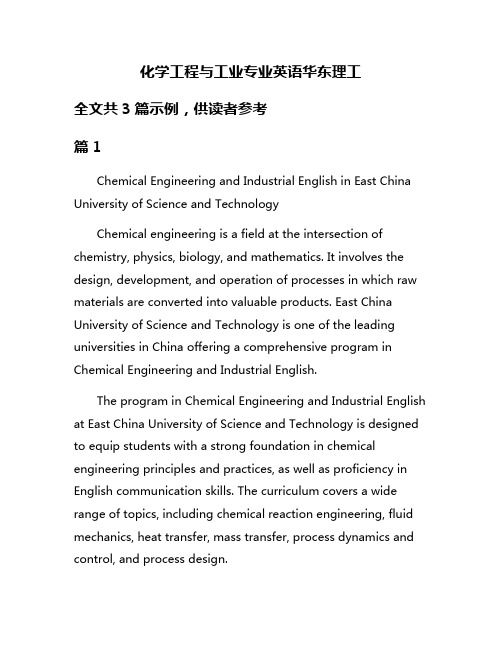
化学工程与工业专业英语华东理工全文共3篇示例,供读者参考篇1Chemical Engineering and Industrial English in East China University of Science and TechnologyChemical engineering is a field at the intersection of chemistry, physics, biology, and mathematics. It involves the design, development, and operation of processes in which raw materials are converted into valuable products. East China University of Science and Technology is one of the leading universities in China offering a comprehensive program in Chemical Engineering and Industrial English.The program in Chemical Engineering and Industrial English at East China University of Science and Technology is designed to equip students with a strong foundation in chemical engineering principles and practices, as well as proficiency in English communication skills. The curriculum covers a wide range of topics, including chemical reaction engineering, fluid mechanics, heat transfer, mass transfer, process dynamics and control, and process design.One of the key features of the program is the emphasis on developing English language proficiency. Students are required to take courses in English for Specific Purposes, which focus on technical vocabulary, writing skills, and presentation skills relevant to the field of chemical engineering. In addition, students have the opportunity to participate in research projects and internships where they can apply their knowledge and improve their English communication skills in a professional setting.The faculty members in the Department of Chemical Engineering at East China University of Science and Technology are experts in their field with extensive research experience and industry connections. They provide students with personalized attention and guidance, helping them to develop their technical skills and English proficiency.In addition to the academic curriculum, students in the Chemical Engineering and Industrial English program have access to state-of-the-art laboratories and facilities, where they can conduct experiments and research projects under the supervision of faculty members. They also have the opportunity to participate in extracurricular activities, such as student organizations and industry conferences, which allow them tonetwork with professionals in the field and gain real-world experience.Upon graduation, students from the Chemical Engineering and Industrial English program at East China University of Science and Technology are well-prepared to pursue careers in a variety of industries, including chemical manufacturing, pharmaceuticals, biotechnology, energy, and environmental engineering. They have the technical skills, critical thinking abilities, and English language proficiency needed to succeed in today's globalized and competitive job market.Overall, the program in Chemical Engineering and Industrial English at East China University of Science and Technology provides students with a comprehensive and rigorous education that prepares them for successful careers in the field of chemical engineering. The combination of technical expertise and English proficiency gives graduates a competitive edge in the job market and ensures that they are well-equipped to meet the challenges of the modern workplace.篇2Chemical Engineering and Industry at East China University of Science and TechnologyChemical engineering is a branch of engineering that applies physical sciences and life sciences together with mathematics and economics to produce, transform, transport, and properly use chemicals, materials, and energy. It deals with the design and operation of plants and processes for the chemical transformations of raw materials into valuable products. The field combines principles from chemistry, physics, biology, and mathematics to carry out industrial processes that have a major impact on the everyday life of society.East China University of Science and Technology (ECUST) is a prestigious university in Shanghai, China that offers a comprehensive chemical engineering program with a focus on industry development and research. The Chemical Engineering and Industry Department at ECUST provides students with a solid foundation in the principles of chemical engineering, as well as hands-on experience in various industrial applications.The curriculum at ECUST covers a wide range of topics, including material and energy balances, transport phenomena, thermodynamics, reaction engineering, process control, and safety. Students also have the opportunity to specialize in areas such as environmental engineering, bioengineering, and petrochemical engineering.In addition to classroom learning, students at ECUST have the opportunity to gain practical experience through internships at companies and research institutions. The university has strong connections with leading chemical engineering companies in China, providing students with valuable networking opportunities and access to cutting-edge research and technology.ECUST is also known for its research in chemical engineering and industry. The university has state-of-the-art laboratories and research facilities where students and faculty conduct groundbreaking research in areas such as catalysis, nanotechnology, and renewable energy. The university also collaborates with industry partners on research projects, providing students with real-world experience and connections in the chemical engineering industry.Overall, the Chemical Engineering and Industry Department at East China University of Science and Technology provides students with a comprehensive education in chemical engineering, preparing them for successful careers in a wide range of industries. The university's strong focus on research and industry connections also ensures that students are at the forefront of the latest developments in the field. If you areinterested in pursuing a career in chemical engineering, ECUST is an excellent choice for your education.篇3Chemical Engineering and Industry at East China University of Science and TechnologyIntroductionChemical engineering is a branch of engineering that applies principles of chemistry, physics, and biology to solve problems involving the production and use of chemicals, materials, energy, and pharmaceuticals. The field covers a wide range of areas including process design, plant operations, environmental protection, and product development. East China University of Science and Technology is one of the leading institutions in China offering a major in Chemical Engineering and Industry. This program prepares students for careers in various industries such as petrochemicals, pharmaceuticals, food processing, environmental engineering, and more.Program StructureThe Chemical Engineering and Industry program at East China University of Science and Technology is a four-year undergraduate program. The curriculum is designed to providestudents with a comprehensive understanding of chemical engineering principles and practices. Students will take courses in subjects such as organic chemistry, inorganic chemistry, physical chemistry, chemical reaction engineering, process control, and separation processes. In addition to classroom learning, students will have the opportunity to participate in laboratory experiments, internships, and research projects.Career OpportunitiesGraduates of the Chemical Engineering and Industry program at East China University of Science and Technology have a wide range of career opportunities available to them. They can work in industries such as oil and gas, pharmaceuticals, food and beverage, environmental engineering, and more. Some common job titles for graduates of this program include process engineer, production manager, quality control engineer, and environmental engineer. With the rapid growth of industries in China, there is a high demand for talented and skilled chemical engineers.Research OpportunitiesAs a leading research institution, East China University of Science and Technology provides students with ample opportunities to participate in research projects related tochemical engineering. Students can work with faculty members on projects ranging from new materials development to process optimization. Research experience is an important aspect of the program as it helps students develop critical thinking, problem-solving, and analytical skills. Students who excel in research may have the opportunity to publish their findings in academic journals or present at conferences.Facilities and ResourcesEast China University of Science and Technology is equipped with state-of-the-art facilities and resources to support the Chemical Engineering and Industry program. The university has well-equipped laboratories for conducting experiments in areas such as chemical synthesis, process modeling, and environmental analysis. In addition, students have access to a wide range of academic journals, databases, and software tools to support their learning and research activities. The university also has strong industry connections, providing students with opportunities for internships and networking with professionals in the field.ConclusionThe Chemical Engineering and Industry program at East China University of Science and Technology offers students acomprehensive education in chemical engineering principles and practices. With a strong emphasis on research, hands-on learning, and industry connections, graduates of this program are well-prepared for successful careers in the chemical engineering field. Whether students are interested in working in traditional industries or emerging fields, the program provides a solid foundation for future success.。
化工专业英语翻译(全21单元)
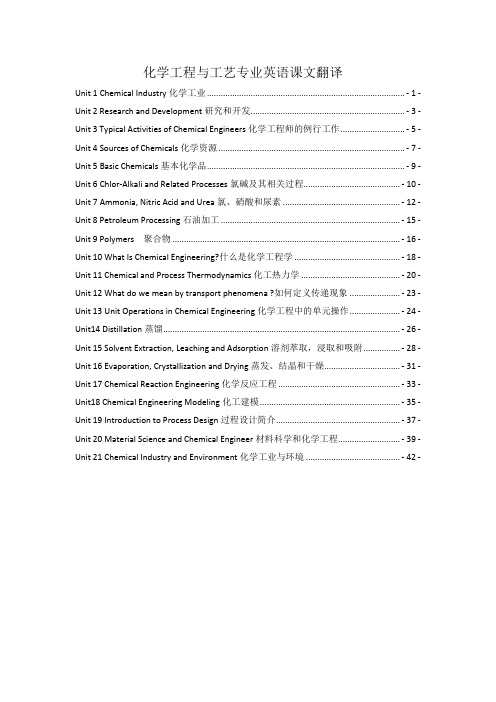
化学工程与工艺专业英语课文翻译Unit 1 Chemical Industry化学工业 ...................................................................................... - 1 -Unit 2 Research and Development研究和开发................................................................... - 3 -Unit 3 Typical Activities of Chemical Engineers化学工程师的例行工作............................ - 5 -Unit 4 Sources of Chemicals化学资源 ................................................................................. - 7 -Unit 5 Basic Chemicals基本化学品...................................................................................... - 9 -Unit 6 Chlor-Alkali and Related Processes氯碱及其相关过程.......................................... - 10 -Unit 7 Ammonia, Nitric Acid and Urea氯、硝酸和尿素 ................................................... - 12 -Unit 8 Petroleum Processing石油加工 .............................................................................. - 15 -Unit 9 Polymers 聚合物 ................................................................................................... - 16 -Unit 10 What Is Chemical Engineering?什么是化学工程学 .............................................. - 18 -Unit 11 Chemical and Process Thermodynamics化工热力学 ........................................... - 21 -Unit 12 What do we mean by transport phenomena ?如何定义传递现象 ...................... - 23 -Unit 13 Unit Operations in Chemical Engineering化学工程中的单元操作...................... - 24 -Unit14 Distillation蒸馏....................................................................................................... - 26 -Unit 15 Solvent Extraction, Leaching and Adsorption溶剂萃取,浸取和吸附................ - 28 -Unit 16 Evaporation, Crystallization and Drying蒸发、结晶和干燥................................. - 31 -Unit 17 Chemical Reaction Engineering化学反应工程 ..................................................... - 33 -Unit18 Chemical Engineering Modeling化工建模 ............................................................. - 36 -Unit 19 Introduction to Process Design过程设计简介...................................................... - 37 -Unit 20 Material Science and Chemical Engineer材料科学和化学工程........................... - 39 -Unit 21 Chemical Industry and Environment化学工业与环境 ......................................... - 42 -Unit 1 Chemical Industry化学工业1.化学工业的起源尽管化学品的使用可以追溯到古代文明时代,我们所谓的现代化学工业的发展却是非常近代(才开始的)。
- 1、下载文档前请自行甄别文档内容的完整性,平台不提供额外的编辑、内容补充、找答案等附加服务。
- 2、"仅部分预览"的文档,不可在线预览部分如存在完整性等问题,可反馈申请退款(可完整预览的文档不适用该条件!)。
- 3、如文档侵犯您的权益,请联系客服反馈,我们会尽快为您处理(人工客服工作时间:9:00-18:30)。
Unit 1 Chemical Industry化学工业1.Origins of the Chemical IndustryAlthough the use of chemicals dates back to the ancient civilizations, the evolution of what we know as the modern chemical industry started much more recently. It may be considered to have begun during the Industrial Revolution, about 1800, and developed to provide chemicals roe use by other industries. Examples are alkali for soapmaking, bleaching powder for cotton, and silica and sodium carbonate for glassmaking. It will be noted that these are all inorganic chemicals. The organic chemicals industry started in the 1860s with the exploitation of William Henry Perkin’s discovery if the first synthetic dyestuff—mauve. At the start of the twentieth century the emphasis on research on the applied aspects of chemistry in Germany had paid off handsomely, and by 1914 had resulted in the German chemical industry having 75% of the world market in chemicals. This was based on the discovery of new dyestuffs plus the development of both the contact process for sulphuric acid and the Haber process for ammonia. The later required a major technological breakthrough that of being able to carry out chemical reactions under conditions of very high pressure for the first time. The experience gained with this was to stand Germany in good stead, particularly with the rapidly increased demand for nitrogen-based compounds (ammonium salts for fertilizers and nitric acid for explosives manufacture) with the outbreak of world warⅠin 1914. This initiated profound changes which continued during the inter-war years (1918-1939).1.化学工业的起源尽管化学品的使用可以追溯到古代文明时代,我们所谓的现代化学工业的发展却是非常近代(才开始的)。
可以认为它起源于工业革命其间,大约在1800年,并发展成为为其它工业部门提供化学原料的产业。
比如制肥皂所用的碱,棉布生产所用的漂白粉,玻璃制造业所用的硅及Na2CO3. 我们会注意到所有这些都是无机物。
有机化学工业的开始是在十九世纪六十年代以William Henry Perkin 发现第一种合成染料—苯胺紫并加以开发利用为标志的。
20世纪初,德国花费大量资金用于实用化学方面的重点研究,到1914年,德国的化学工业在世界化学产品市场上占有75%的份额。
这要归因于新染料的发现以及硫酸的接触法生产和氨的哈伯生产工艺的发展。
而后者需要较大的技术突破使得化学反应第一次可以在非常高的压力条件下进行。
这方面所取得的成绩对德国很有帮助。
特别是由于1914年第一次世界大仗的爆发,对以氮为基础的化合物的需求飞速增长。
这种深刻的改变一直持续到战后(1918-1939)。
date bake to/from: 回溯到dated: 过时的,陈旧的stand sb. in good stead: 对。
很有帮助Since 1940 the chemical industry has grown at a remarkable rate, although this has slowed significantly in recent years. The lion’s share of this growth has been in the organic chemicals sec tor due to the development and growth of the petrochemicals area since 1950s. The explosives growth in petrochemicals in the 1960s and 1970s was largely due to the enormous increase in demand for synthetic polymers such as polyethylene, polypropylene,nylon, polyesters and epoxy resins.1940年以来,化学工业一直以引人注目的速度飞速发展。
尽管这种发展的速度近年来已大大减慢。
化学工业的发展由于1950年以来石油化学领域的研究和开发大部分在有机化学方面取得。
石油化工在60年代和70年代的迅猛发展主要是由于人们对于合成高聚物如聚乙烯、聚丙烯、尼龙、聚脂和环氧树脂的需求巨大增加。
The chemical industry today is a very diverse sector of manufacturing industry, within which it plays a central role. It makes thousands of different chemicals which the general public only usually encounter as end or consumer products. These products are purchased because they have the required properties which make them suitable for some particular application, e.g. a non-stick coating for pans or a weedkiller. Thus chemicals are ultimately sold for the effects that they produce.今天的化学工业已经是制造业中有着许多分支的部门,并且在制造业中起着核心的作用。
它生产了数千种不同的化学产品,而人们通常只接触到终端产品或消费品。
这些产品被购买是因为他们具有某些性质适合(人们)的一些特别的用途,例如,用于盆的不粘涂层或一种杀虫剂。
这些化学产品归根到底是由于它们能产生的作用而被购买的。
2. Definition of the Chemical IndustryAt the turn of the century there would have been little difficulty in defining what constituted the chemical industry since only a very limited range of products was manufactured and these were clearly chemicals, e.g., alkali, sulphuric acid. At present, however, many intermediates to products produced, from raw materials like crude oil through (in some cases) many intermediates to products which may be used directly as consumer goods, or readily converted into them. The difficulty cones in deciding at which point in this sequence the particular operation ceases to be pa rt of the chemical industry’s sphere of activities. To consider a specific example to illustrate this dilemma, emulsion paints may contain poly (vinyl chloride) / poly (vinyl acetate). Clearly, synthesis of vinyl chloride (or acetate) and its polymerization are chemical activities. However, if formulation and mixing of the paint, including the polymer, is carried out by a branch of the multinational chemical company which manufactured the ingredients, is this still part of the chemical industry of does it mow belong in the decorating industry?2.化学工业的定义在本世纪初,要定义什么是化学工业是不太困难的,因为那时所生产的化学品是很有限的,而且是非常清楚的化学品,例如,烧碱,硫酸。
